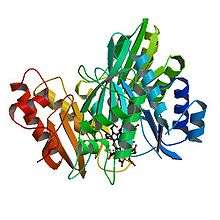Sulfite reductase
| sulfite reductase | |||||||||
|---|---|---|---|---|---|---|---|---|---|
 | |||||||||
| Identifiers | |||||||||
| EC number | 1.8.99.1 | ||||||||
| CAS number | 37256-51-2 | ||||||||
| Databases | |||||||||
| IntEnz | IntEnz view | ||||||||
| BRENDA | BRENDA entry | ||||||||
| ExPASy | NiceZyme view | ||||||||
| KEGG | KEGG entry | ||||||||
| MetaCyc | metabolic pathway | ||||||||
| PRIAM | profile | ||||||||
| PDB structures | RCSB PDB PDBe PDBsum | ||||||||
| Gene Ontology | AmiGO / EGO | ||||||||
| |||||||||
Sulfite reductases (EC 1.8.99.1) are important enzymes in the process of sulfur metabolism.[2] They catalyze the reduction of sulfite to hydrogen sulfide and water.[2][3] Electrons for the reaction are provided by a dissociable molecule of either NADPH, bound flavins, or ferredoxins.[4]
- SO32− (sulfite) + electron donor H2S (hydrogen sulfide) + oxidized donor + 3 H2O
Sulfite reductases belong to the family of oxidoreductases, and are found in archaea, bacteria, fungi, and plants.[5] They are grouped as either assimilatory or dissimilatory sulfite reductases depending on their function, their spectroscopic properties, and their catalytic properties. This enzyme participates in selenoamino acid metabolism and sulfur assimilation. It employs two covalently coupled cofactors - an iron sulfur cluster and a siroheme - which deliver electrons to the substrate via this coupling.[6]
The systematic name of this enzyme class is hydrogen-sulfide:acceptor oxidoreductase. Other names in common use include assimilatory sulfite reductase, assimilatory-type sulfite reductase, and hydrogen-sulfide:(acceptor) oxidoreductase.
References
- ↑ PDB: 1AOP; Crane BR, Siegel LM, Getzoff ED (October 1995). "Sulfite reductase structure at 1.6 Å: evolution and catalysis for reduction of inorganic anions". Science. 270 (5233): 59–67. doi:10.1126/science.270.5233.59. PMID 7569952.
- 1 2 Parey K, Warkentin E, Kroneck PM, Ermler U (2010). "Reaction cycle of the dissimilatory sulfite reductase from Archaeoglobus fulgidus". Biochemistry. 49 (41): 8912–8921. doi:10.1021/bi100781f. PMID 20822098.
- ↑ Pinto R, Harrison JS, Hsu T, Jacobs WR, Leyh TS (September 2007). "Sulfite Reduction in Mycobacteria". J. Bacteriol. 189 (18): 6714–22. doi:10.1128/JB.00487-07. PMC 2045171
 . PMID 17644602.
. PMID 17644602. - ↑ Siegel LM, Murphy MJ, Kamin H (January 1973). "Reduced nicotinamide adenine dinucleotide phosphate-sulfite reductase of enterobacteria. I. The Escherichia coli hemoflavoprotein: molecular parameters and prosthetic groups". J. Biol. Chem. 248 (1): 251–64. PMID 4144254.
- ↑ Schnell R, Sandalova T, Hellman U, Lindqvist Y, Schneider G (July 2005). "Siroheme- and [Fe4-S4]-dependent NirA from Mycobacterium tuberculosis is a sulfite reductase with a covalent Cys-Tyr bond in the active site". J. Biol. Chem. 280 (29): 27319–28. doi:10.1074/jbc.M502560200. PMID 15917234.
- ↑ Crane BR, Getzoff ED (December 1996). "The relationship between structure and function for the sulfite reductases". Curr. Opin. Struct. Biol. 6 (6): 744–56. doi:10.1016/S0959-440X(96)80003-0. PMID 8994874.
Further reading
- Asada K (August 1967). "Purification and properties of a sulfite reductase from leaf tissue". J. Biol. Chem. 242 (16): 3646–54. PMID 6038492.
- Asada K, Tamura G, Bandurski RS (September 1969). "Methyl viologen-linked sulfite reductase from spinach leaves". J. Biol. Chem. 244 (18): 4904–15. PMID 5824566.
- Yoshimoto A, Nakamura T, Sato R (December 1967). "Isolation from Aspergillus nidulans, of a protein catalyzing the reduction of sulfite by reduced viologen dyes". J. Biochem. 62 (6): 756–66. PMID 5589532.